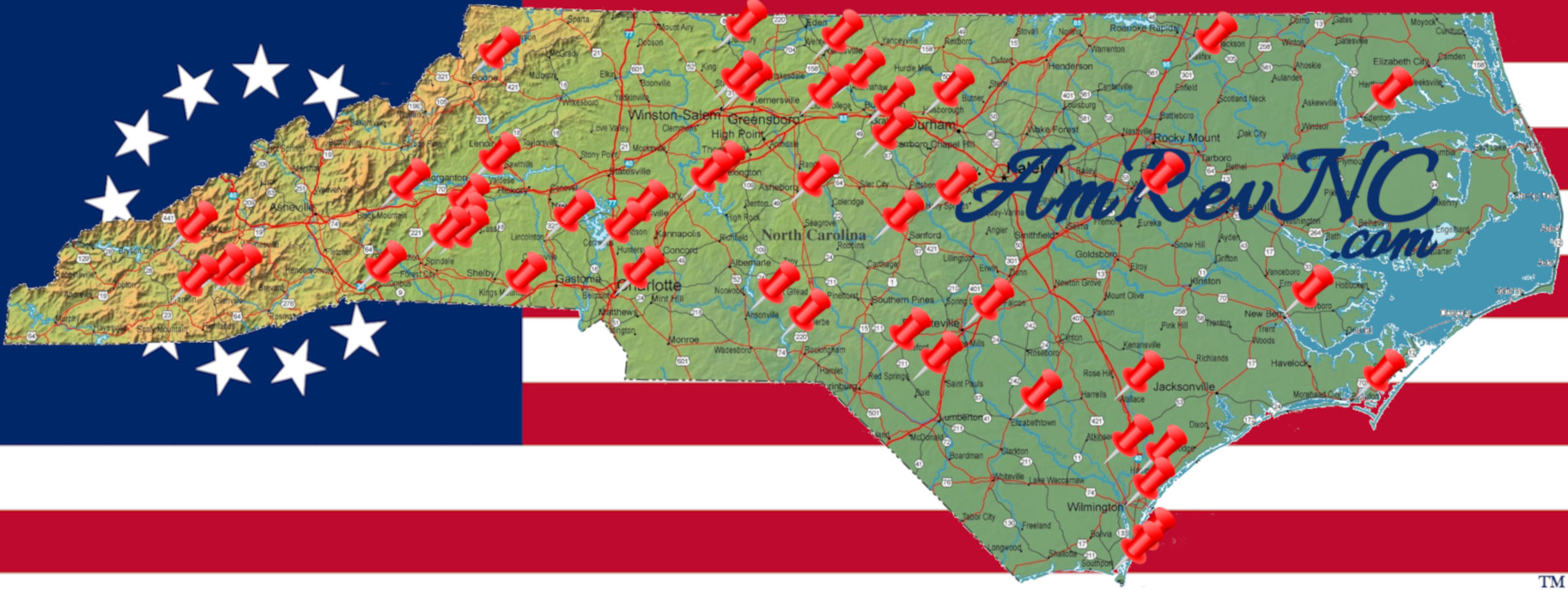The Guns of N.C.
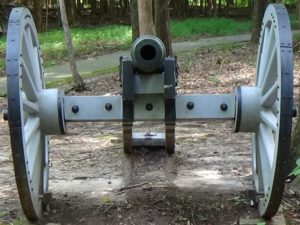
Despite the fear that cannons or “artillery” caused in the soldiers of the American Revolution, they did not play a major role in the war in North Carolina. Neither the Continental nor British armies had enough here to turn the tide of battle in most cases.
However, cannons play supporting roles in a number of N.C. stories from before the Revolution through to its end. They signaled the start of the Battle of Alamance against the Regulators, and were the source of an early confrontation between rebels and the colonial governor in New Bern. The most famous cannons in N.C.’s war were probably a myth, but the ones that actually were at the Battle of Moore’s Creek contributed to the quick Patriot victory. The Patriots and British tussled over a set of cannons at Fort Johnston. Another myth arose over artillery at Guilford Court House, where the British used it to fight off a Continental counter-attack. A drunken citizen’s firing of cannons in Beaufort caused problems, but those at the town fort could not fight off a raid near the end of the war.
Elsewhere in the young United States, large “siege” cannons and short-barreled guns such as “mortars” were used against defense works. No records indicate these were used in North Carolina, so this page mostly focuses on “field” guns used by armies on the move.
What They Looked Like
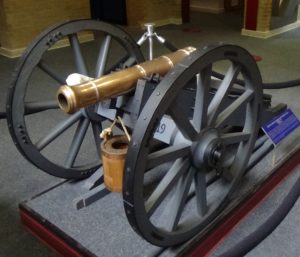
A cannon was basically just a large gun barrel: a thick-walled tube of bronze or iron, open on one end (the “mouth”). Iron barrels were cheaper and stronger, so more gunpowder could be used to send their shots further. But bronze was lighter and thus preferred for land campaigns.[1] Bronze also lasted longer, and could be melted down and recast. In both types, the insides were smooth, not grooved like rifles carried by some soldiers. A small “touch hole” or “vent” was on the top near the closed end, the “breech.” The vent was used to fire the cannon, as you’ll see.
Cannons were named by the weight—and therefore size—of iron cannonball they shot. The cannons used before and during the Revolution in N.C. were three-, six-, or nine-pounders. Also used were 1.5-pound “swivel guns,” tiny cannons on stands with metal spikes in the bottom. The spikes were driven into something made of wood, like a fence post or tree stump, or placed in a holder on the edge of a boat.
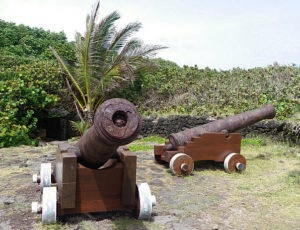
For the larger guns, the barrel would be attached to a wooden platform on wheels. Ship and fort cannons used “trucks,” two vertical sides of wood the gun sat on, with four small wheels on the bottom platform. Field guns were placed on carriages with two large wheels and one or two “trails” for pulling. Often these were attached to carts called “limbers” that carried powder and ammunition. A 1757 writer said one horse was needed for three-pounders and two for six-pounders.[2] Artillery in forts originally had the ship type of carriage, but later in the war might use either. The carriages were painted various colors, though one source says that in 1780, Gen. George Washington “ordered all carriages painted a light blue in honor of France, light blue being the French royal color.”[3]
The Continental Army’s first cannons were captured British ones. But by 1776, American foundries were producing them—some stamped “UC” for “United Colonies!”[4] One advantage of France becoming an ally was that French artillery was the best in the world, and that began arriving along with supplies in 1778.[5]
The first cannons in North Carolina were seized from the colonial government, but the state arranged to buy some Spanish cannons that arrived by chance in Edenton in 1778. Small foundries in the state, like the Troublesome Creek Ironworks north of today’s Greensboro, could make cannon balls. The guns used in the campaigns of 1780-1 came from out-of-state with the two regular armies.
How They Worked
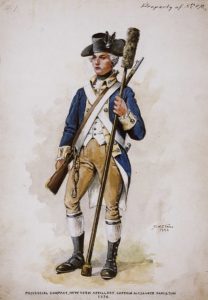
Specially trained artillery crews fired cannons, at least six men each including the gun commander, plus six more who merely moved the piece around. After a shot, one soldier used a long stick with what looked like a wine corkscrew on the end, called a “worm,” to clear out any remaining powder or bits of paper or fabric that held it. Then another would push a stick with a wet “sponge” (actually lambskin or animal bristles) down the barrel to cool it down and clean it. Sometimes the worm and sponge were on the same stick. Then a small fabric bag filled with gunpowder, a “cartridge,” was pushed down the barrel, or powder could be poured in, and something flammable like straw or paper pushed on top. The powder was made from saltpeter (potassium nitrate), sulphur, and charcoal.
A cartridge might also be wrapped with a cannonball. Otherwise, the ammunition or “shot” was put in the mouth and rammed into place using a stick with what looked like a small wooden barrel on its end (sometimes the same stick with the sponge). The remaining men retrieved supplies. Any mistake in the loading process—not wiping the barrel clean, adding too much powder, loading two shots at once in the heat of battle, and so on—could cause the cannon to explode.
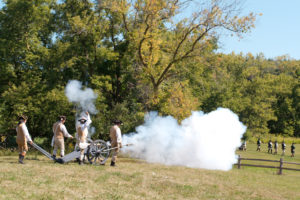
How They were Used
Besides aiming side to side, the “gunner” also had to set the angle or “elevation” of the barrel to reach the target, using wooden wedges or a screw between the barrel and carriage. A gun set at a 45-degree angle fired solid shot 10 times further than one pointed straight ahead.[6] But greater elevations were also less accurate.
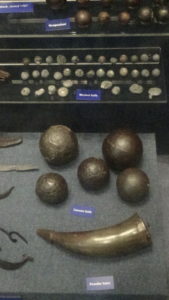
The most common types of shot were:
- “Solid” shot, a ball of iron. In battle these would be fired at the enemy’s artillery, or aimed low to skip across the ground against troops.
- Hollow, powder-filled shot called “shells” or “bombs.” These were fired against ships, buildings, and fortifications, but do not appear to have been used in N.C.
- “Case” and “cannister” shots were thin metal cans with bases of wood, sometimes reinforced with metal rings. These were filled with bullets (cannister) or larger iron balls (case)[7]. They worked like big shotguns, spewing the contents, and the remains of the can, into soldiers on the other side.
- “Grape” shot was basically the same as the last two, but the balls were between the two in size, about 50% larger than cannister/musket balls. Also, the balls were in a fabric bag attached to the base. A cord was wrapped around the balls on the outsides of the bag in a way that made them look like grapes.[8] (However, “grape shot” was often used as a general term for this type, case, and cannister shot.)
Typical crews using cartridges could fire four times a minute, though, “A Hessian artillery unit… gave a demonstration in which it fired 12 rounds a minutes!”[9] In theory an expert crew could hit targets a half-mile or more away. Because of drift as the round ball sailed, the effective range for most cannons was at most 1,000 yards. But typically most crews needed to be much closer. Since gunners had to see where their shots landed to correct their aim, typical ranges were more like 500 yards or less.[10] Only one record of accuracy from the war’s era has been found, for case shot, from a 1780 test in England. At 200 yards (the length of two American football fields), about half of the test rounds hit a target; at 500 yards, that was down to 14%![11]
More Information
- ‘A Closer Look: An 18th Century Cannon | Heinz History Center’, Home, 2015 <https://www.heinzhistorycenter.org/blog/fort-pitt-museum/a-closer-look-18th-century-cannon> [accessed 5 November 2020]
- ‘Artillery of the Eighteenth Century | Encyclopedia.Com’ <https://www.encyclopedia.com/history/encyclopedias-almanacs-transcripts-and-maps/artillery-eighteenth-century> [accessed 5 November 2020]
- ‘Cannon in the American Revolutionary War’, Revolutionary War Journal, 2015 <http://www.revolutionarywarjournal.com/war-cannon/> [accessed 5 November 2020]
- ‘Cannon Projectiles of the American Revolutionary War – Revolutionary War Journal’ <https://www.revolutionarywarjournal.com/cannon-projectiles/> [accessed 9 November 2020]
- ‘Firing Field Cannon in the American Revolutionary War’, Revolutionary War Journal, 2014 <http://www.revolutionarywarjournal.com/firing-field-cannon/> [accessed 5 November 2020]
- Greene, Jerome, “The Allies at Yorktown: A Bicentennial History of the Siege of 1781” (Denver, Colo.: National Park Service, 1976) <https://www.nps.gov/parkhistory/online_books/colo1/hrs.pdf> [accessed 20 October 2021]
- Hatton, Richard, ‘Artillery at the Battle of Alamance–May 16, 1771’, 2022
- Laskow, Sarah, ‘This Revolutionary War Shot Still Has Traces of Human Blood on It’, Atlas Obscura, 400AD <http://www.atlasobscura.com/articles/revolutionary-war-shot-musket-ball-blood> [accessed 9 November 2020]
- Pancake, John S., This Destructive War: The British Campaign in the Carolinas, 1780-1782 (University, AL : University of Alabama Press, 1985) <http://archive.org/details/thisdestructivew00panc> [accessed 13 October 2020]
- Peterson, Harold, The Book of the Continental Soldier (Harrisburg, Pa.: The Stackpole Company, 1968).
- Soodalter, Ron, ‘Arming the Revolution: Where Did the Continental Army Get Its Cannons?’, HistoryNet, 2017 <https://www.historynet.com/arming-revolution-continental-army-get-cannons.htm> [accessed 5 November 2020]
- ‘Tin Case Shot or Canister Shot in the 18th Century for Artillery’ <http://www.militaryheritage.com/caseshot.htm> [accessed 9 November 2020]
- S. National Park Service, ‘Revolutionary War Artillery’, Yorktown Battlefield Part of Colonial National Historical Park, 2015 <https://www.nps.gov/york/learn/historyculture/revolutionary-war-artillery.htm> [accessed 5 November 2020]
- ‘Weapons of the American Revolution—Artillery’, AmericanRevolution.Org <https://www.americanrevolution.org/artillery.php> [accessed 5 November 2020]
[1] “Weapons of the American Revolution—Artillery.”
[2] Greene 1976.
[3] Weapons.
[4] Greene.
[5] Ibid.
[6] Ibid.
[7] Modern sources are inconsistent on which type is “case” and which is “cannister.” One source indicates the terms were reversed in England (see Footnote 10). We have gone with the usage appearing in the majority of our sources.
[8] Weapons.
[9] Ibid.; Hessian quotation from Pancake 1985.
[10] Peterson 1968.
[11] “Tin Case Shot or Canister Shot in the 18th Century for Artillery”: This article says “case” was called “cannister” in America, but it’s only picture of shot has the larger balls and calls it case shot.
